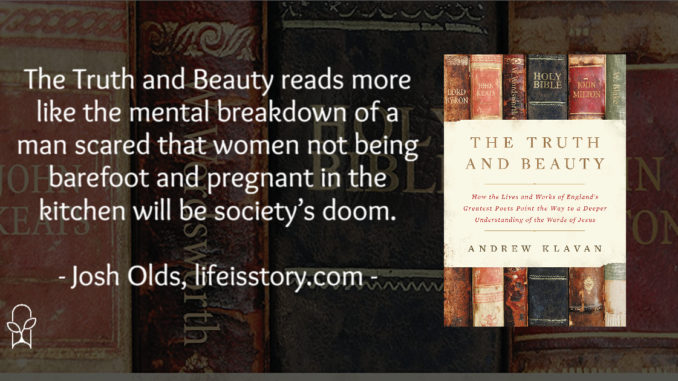
Published by Zondervan on April 5, 2022
Goodreads
Follow Andrew Klavan to a deeper, richer understanding of the words of Jesus.
Andrew Klavan believed what he read in the Gospels, but he often struggled to understand what Jesus really meant. So he began a journey of wrestling with the beautiful and often strange words of Jesus.
He learned Greek in order to read the Gospels in their original languages, and he vowed to set aside any preconceptions about what the Scriptures say. But it wasn't until he began exploring how some of history's greatest writers wrestled with the same issues we confront today--political upheaval, rejection of social norms, growing disbelief in God--that he found a new way of understanding what Jesus meant.
In The Truth and Beauty, Klavan combines a decades-long writing career with a lifetime of reading to discover a fresh understanding of the Gospels. By reading the words of Jesus through the life and work of writers such as William Wordsworth and John Keats, Mary Shelley and Samuel Taylor Coleridge--the English romantics--Klavan discovered a way to encounter Jesus in a deeper and more profound way than ever before.
For readers seeking to find renewed meaning in the words of Jesus--and for those who are striving for belief in a materialistic world--The Truth and Beauty offers an intimate account of one man's struggle to understand the Gospels in all their strangeness, and so find his way to a life that is, as he says, "the most creative, the most joyful, and surely the most true."
I don’t know that I’ve ever read a book that misrepresented itself so badly through the title and back cover synopsis. Given the lengthy and specific title, The Truth and Beauty: How the Lives and Works of England’s Greatest Poets Point the Way to a Deeper Understanding of the Words of Jesus, Andrew Klavan’s central thesis seems fairly clear: By understanding the English romantics, we can come to a better understanding of Jesus. Why, then, does Klavan continually litter condescending and irrelevant culture war drivel? Some examples:
“A police officer shoots a violent black criminal—or is the cop the criminal and the black man a victim of a system that privileges whiteness so that his criminality is really a kind of justice?” (p. 65)
“Through the miracle of science, a woman can now medicate her body so that men may use it for pleasure without consequence or attachment.” (p. 88)
“Viewers who did not go into ecstasies over a wooden piece of second-rate silliness like Black Panther were suspected of being racist because the hero was black.” (p. 92)
“Perhaps so-called sex change operations will no longer be a cosmetic illusion reinforced by this misuse of him and her pronouns, but a genuine fact of technological life. Perhaps then the humanizing tasks of femininity—creating life out of matter, homes out of houses, minds out of brains, and souls out of bodies—will fall equally on the genders…” (p. 94)
“The marketplace does not want to lose its women workers to the nursery. The state does not want to cede its power to the fathers of families. In material terms, it’s unfair; it’s oppressive. So the world is sure to turn to its science and technology and social systems to ‘solving the problem’ of gender, which is really just the problem of femininity and its core in spiritual action. The world will learn to grow babies in machines, to nurture them in institutions, to free women for the market, to strip men of their authority, to make us the same.” (p. 183)
From beginning to end, The Truth and Beauty reads more like the mental breakdown of a man scared that women not being barefoot and pregnant in the kitchen will be society’s doom. (You can imagine, then what he thinks of the lives of the English romantics—proto-feminist Mary Shelley, in particular.) In this book, there is little truth, scant beauty, and barely anything of Jesus.
Indeed, the words of Jesus are barely discussed at all, relegated to the book’s final section. Klavan is not a biblical scholar or theologian, nor is he a pastor or in any way trained in reading or exegeting Scripture. That amateurism shows. For literary effect, he reworks the chronology of Jesus to place the wedding at Cana near the end of Jesus’s ministry—because it better fits the narrative he wants to establish about Mary. He elevates Milton’s creation hierarchy to the level of inspired Word, writing that man was made for God and woman was made for the God in man. He fundamentally misunderstands the purpose of Jesus weeping at Lazarus’s grave, positing that Jesus is crying over mankind’s blindness and sin. He offers a flawed and banal interpretation of the Sermon on the Mount. And all of these comes in an unfocused meandering ramble that I suppose Klavan felt sounded mystical.
The Truth and the Beauty is a poor front for Klavan to spout racist and sexist ideologies under the guise of teaching readers about the English romantics and Jesus. He accomplishes neither. There is little to redeem this book, save for some artful phrases about the nature of story. Zondervan should be ashamed that they’ve published this.
